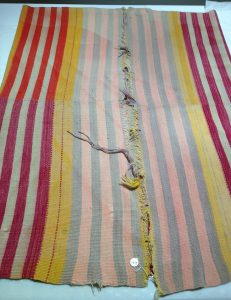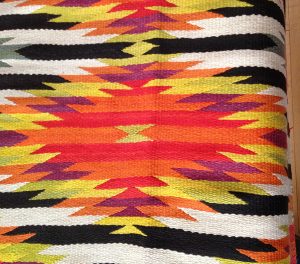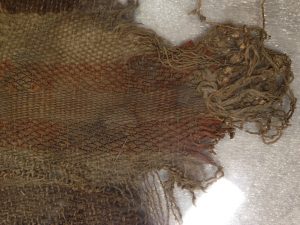The main project of my internship was to curate, plan, and develop an exhibit of Rio Grande textiles from the Luther Bean Museum (LBM) collection. I had learned much from my own research, the Mark Winter NMAM 2018 conference lectures, and especially my visits to the Millicent Rogers Museum. My concept for the exhibit was to showcase the two main weaving techniques of Rio Grande textiles: double width and two widths seamed (as discussed in the blog: Rio Grande Textile Weaving Details, published Feb 14, 2019). I also wanted to display a variety of colors and band patterning. From the collection, I selected eight textiles for the exhibit.

Textile needs conservation treatment – LBM collection
Because the Luther Bean Museum has limited wall space for additional exhibits, the Rio Grande textiles exhibit would be hung in the stairwell between the main floor and the mezzanine level. I measured the walls, horizontals and verticals, and determined the distance that we would wish to maintain above the handrails. I made a number of iterations of display designs, attempting to place all eight textiles in the stairwell walls, but it would be a tight fit. With Tawney’s input, I concluded that I could place only one textile on each of four walls and a fifth textile on the mezzanine level.
We needed to inspect all of the selected textiles to ensure that they were in good condition for display. One by one, Tawney and I brought out the textiles, inspected for stability, determined the hanging end and hanging face, and measured the ends (since the measurements almost always differ). We determined that several were not suitable for display without conservation treatment. Several textiles, as in the above photograph, had damaged ends, and a few others had small areas of damage. In these cases, we felt that the textile was not sufficiently stable to withstand the stress of hanging. I was able to keep the exhibit concept, but revised the textiles that would be displayed.



